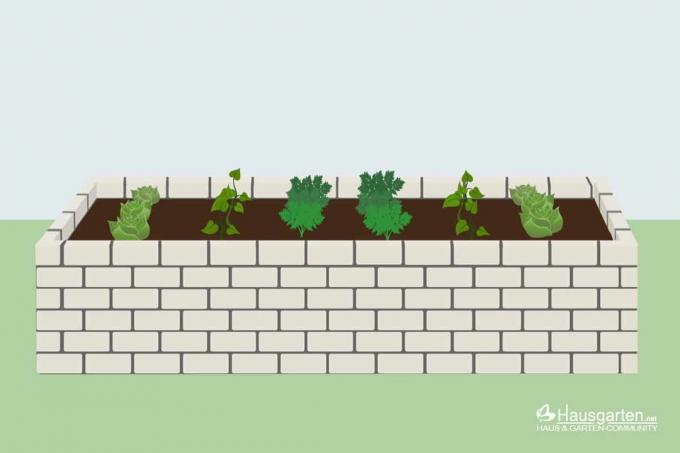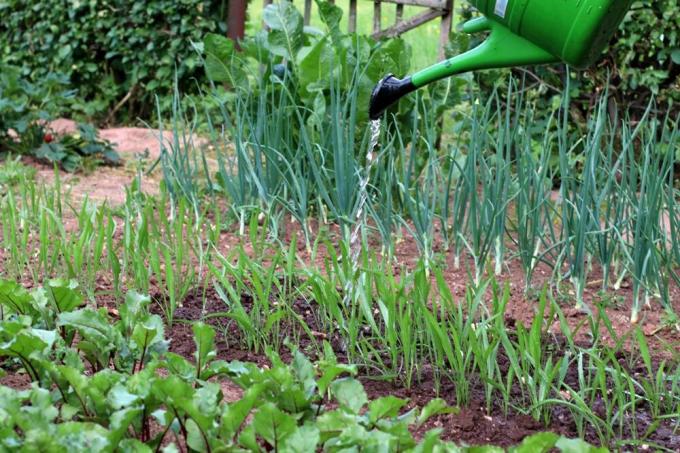

Table of contents
- Filling the raised bed – the best time
- Construction of a raised bed
- Different raised beds for different purposes
- Filling a classic vegetable raised bed
- First layer: drainage layer
- Second layer: soil mixture
- Third layer: wood core
- Fourth layer: center core
- Fifth layer: Finely sieved compost
- Renovation of the raised bed
Practical, modern and easy on the back – raised beds are trendy. Anyone who owns such a system can be one of the first to enjoy crisp lettuce in spring. And in the course of a long life as a gardener, the waist-high bed becomes increasingly indispensable when the constant bending over causes problems and your back hurts after a long day at work. In order for gardening to be successful with the raised bed, however, it is important to fill the construction according to certain criteria.
Filling the raised bed – the best time
For the construction and filling of the raised bed, it is important to wait for the optimal time; for example, both spring and autumn are particularly suitable for creating the bed and then filling it. During this time, there are typically leftover leaves or prunings in the garden, which can be optimally used for filling. Anyone who uses natural materials from their own garden ensures that no impurities or harmful substances get into the system.
Construction of a raised bed
A raised bed consists of three main layers:
- drainage
- compost
- substrate
No matter what type of raised bed is to be created: In any case, the filling material used becomes finer and finer from the bottom layer to the top layer. There is branch clippings and brushwood close to the ground, compost in the middle and potting soil at the top.
Tip:
To protect the raised bed from voles, it has proven useful to cover the floor with a mouse grid.
Different raised beds for different purposes
Today, the raised bed is used for many different needs. Hobby gardeners often use the system for the following purposes:
- as a vegetable patch
- for salad
- as a herb garden
- for flowers

The composition of the content can vary, depending on what uses you want for the raised bed; a classic flower bed can do with a simple layering of air-permeable layer close to the ground, compost as the middle layer and potting soil as the final layer; Plants used for vegetables usually require additional layers. If you want to use your raised bed as a small herb garden, you also have to consider the different needs of the individual herbs; while Mediterranean plants such as rosemary and thyme prefer dry and sandy soil, local herbs (chives or parsley), for example, need fresh soil. In case of doubt, the top layers of earth must be divided into different areas.
Filling a classic vegetable raised bed
Each bed is individual and has certain requirements and different structural conditions. Here we show you how to fill an example bed.
First layer: drainage layer
The first layer the raised bed is filled with is the drainage layer; this has the following properties:
- is up to 30cm thick
- should be at least 10cm
- ensures that no water accumulates in the raised bed
- consists of stones, clay or branches
Anyone who cuts the trees and shrubs in their garden in autumn should carefully store the clippings; it can be used as the first layer of the raised bed. For this purpose, branches up to the thickness of an arm are roughly chopped up and then laid out on the floor of the raised bed. This is followed by thinner layers of brushwood and twigs. Alternatively, rhizomes covered with some soil can be used as filling for the bottom layer. Cardboard or boxes are also suitable, but they must not be printed.
Stones and potsherds can be used as an alternative filling for the first layer. As with the layering with plant material, the same applies here: the individual components become finer and finer from the bottom up. On the ground there are thick shards of clay or larger stones, which are then covered with clay granules or gravel.
Second layer: soil mixture
The first layer of substrate is spread over the drainage layer. This layer has the following properties:
- Thickness about 15cm
- serves to support the decomposition process of the wood core
- Garden soil or finished substrate can be used
The drainage is followed by a layer of sod or semi-decomposed compost, covered with a layer of leaves or straw or a mixture of both components is covered. The final step is a mixture of soil and sifted compost.
Tip:
If Mediterranean plants are to be cultivated, the substrate as a whole must not be too rich in nutrients. In the case of ornamental plants, which generally stay longer in the bed, lava or expanded clay can always be incorporated. In addition, a pH test is suitable, with which the soil can be checked for acidic or alkaline properties; this is crucial for the choice of vegetables.

As an alternative to the substrate mixture from your own garden, you can use quality soil from the specialist market. Here, too, different varieties are available for the individual plant species.
Third layer: wood core
Waste from the garden can be optimally used for the wood core. For example:
- Remnants of shrub pruning
- thin branches and twigs
- chaff
- Plant residues (fruit, vegetables)
- Leftovers from perennial pruning
Tip:
The individual parts that are used to fill this layer must not exceed a total length of about 40cm!

The wood core can be generous in thickness; a total of 40cm should be estimated for this layer. If the layer is thick enough, this ensures that sufficient nutrients and heat, which are important for the plants, are available through the rotting process.
Foliage can be used to cover the wood core; the leaves should be layered three inches high.
Fourth layer: center core
The middle core forms the fourth layer of a raised bed. When applying, please note the following:
- Thickness about 15cm
- Material: stable manure like horse manure or
- coarsely rotted compost
Tip:
If you want to use compost from your own garden for your raised bed, you should never put meat or fish waste there. When composting, it is also important to ensure that no plastic parts get lost in the mixture; the compost should be 100% biodegradable and should therefore only contain food that will decompose.
In addition to the compost, the layer of the wood core can contain beneficial organisms that are specifically settled. They ensure that the compost is broken up and act on a faster rotting process. In this way, important nutrients are released for the plants. If plants are to be grown in the raised bed that have an increased nutrient requirement, the use of a long-term fertilizer is also suitable, with which the bed is enriched. Horn shavings in particular are used for this purpose.
Fifth layer: Finely sieved compost
The last layer of the raised bed is finely sieved compost, which ensures that the plants are supplied with nutrients; in this way they can grow optimally. After the harvest, this layer can be refreshed if necessary before new seedlings are planted. If neither compost nor garden soil from your own green area is available, appropriate substrates can be purchased in specialist stores, for example:
- garden soil (for salad)
- potting soil
- topsoil (ideal for crops)
Renovation of the raised bed
The filling of the raised bed does not remain stable throughout the year; over the course of the months, the entire contents of the system collapse, so that the filling level is reduced by up to 20 cm. Then fresh soil must be refilled. Spring is the best time for this measure, since the entire system is subjected to a thorough inspection at this time. However, the soil cannot be refilled as often as you like.
Usually after five, at the latest after 7 years, the raised bed needs to be renewed. Then the following measures apply:
- Improve construction, repair damaged areas
- Replace contents completely
- Create layering from scratch
Background of these measures:
After a few years, the nutrients contained in the filling are completely used up. This applies not only to structures that serve as a vegetable bed, but also to flower beds. If you take good care of your raised bed over the years, regularly replace the filling and also take care of the overall construction, you will enjoy your system for many years. Then the raised bed remains a popular highlight in the local green area. For back-friendly gardening - into old age!
 garden editorial
garden editorial I write about everything that interests me in my garden.
Learn more about creating a vegetable garden

Build your own raised bed out of stones: this is how it works
Building a raised bed out of stones is more complex than variants made out of wood or aerated concrete. On the other hand, they are very durable, decorative, offer decisive advantages and can even increase yields. We explain how it works here.

18 good neighbors of broccoli | mixed culture
Broccoli is a close relative of cauliflower and a great homegrown vegetable. In the vegetable garden, it is generally advisable to pay attention to good plant neighbors. A corresponding mixed culture has many advantages for all species involved.

Paths in the vegetable garden: 7 ideas for beautiful and practical bed paths
As a rule, there is no way in the vegetable garden without paths. Only through them can all beds be easily reached. Of course you have to think about how to create and design them. Here are some tips and ideas.

Creating a vegetable garden for beginners – instructions incl. plan
Quite a few people today dream of harvesting their own vegetables and being self-sufficient. No wonder: you know where it comes from and what's in it. You are also a bit more independent. Of course you need a garden for that. What is important when creating a vegetable garden is here.

Planning a vegetable garden - my first small self-sufficient garden
The vegetable garden is an important first step on the way to independent self-sufficiency. In order for your self-sufficient life to get off to a good start, it depends on the right planning, from A, for cultivation area, to Z, for fence. This step-by-step guide explains how to make your first small self-sufficient garden perfect.

Choose the right film for the raised bed
Raised beds are not only a big trend, they can make growing fresh vegetables and aromatic herbs a lot easier. With a flexible choice of location, the design options are almost inexhaustible. Raised beds can be made of different materials that suffer to varying degrees from soil moisture. This requires good protection.



